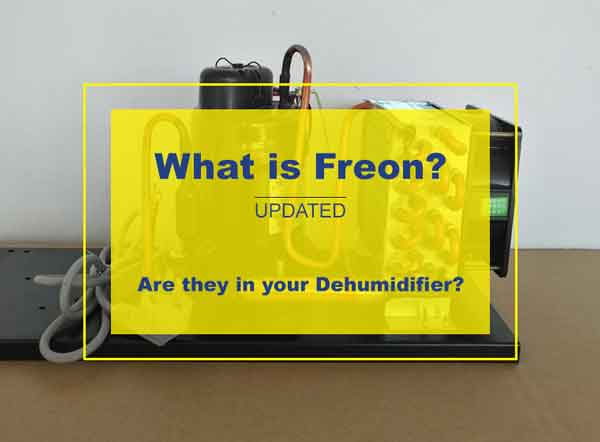Freon is a brand name of air conditioning refrigerant trademarked by DuPont.
Freon, is used by compressor-based dehumidifiers to convert the collected water vapor into condensate, is hazardous to the environment and can also be dangerous to humans after prolonged exposure only if it leaks. However, dehumidifiers are sealed and unless the seal is broken Freon should not leak.
Most dehumidifiers in the market today usually lasts between 5 to 10 years. But if you have any concern about Freon, read further to learn how to detect leakage and preventative measures you should take.
RELATED: If you are worried about the condition of your dehumidifier and would like purchase one without the Freon, check this guide.
Table Of Content
What Causes Freon Leakage in a Dehumidifier?
Freon is contained inside a long copper pipe coiled into loops to form a panel. The main reason for Freon leakage is pipe damage caused by normal wear and tear.
Also, some defects may have occurred during the manufacturing process. Either way, compressor coils should be repaired or replaced by a professional.
How to Detect Freon Leakage
Prolonged exposure to Freon might cut off the oxygen supply to your body’s vital cells and lead to health issues like organ failure, breathing problems, fluid accumulation in the lungs, and sometimes death.
As such, it’s essential to be knowledgeable on the means for detecting Freon leaks in your dehumidifier.
Some of the best methods include using the following:
Electronic Leak Detectors
These devices provide a simple and straightforward way of detecting Freon leakage. They scan around the refrigeration components and make loud alarm sounds to alert you about a Freon leakage.
Soapy Water
To apply this method, you need to use soapy water on the coils and look out for bubbles. The area with the leak is bound to produce loads of bubbles, which should prompt you to call a maintenance specialist.
Ultraviolet Dye
Dye and UV light are also quite efficient in identifying problem areas on your dehumidifier’s coils. This method requires careful application of dye on the coils and the subsequent use of a UV light to illuminate the leak points.
For this purpose, you will want to find a dye compatible with the compressor coils on your unit. If you’re unsure regarding compatibility, ensure to use the dye sparingly to prevent damage.
What Does Freon Smell Like?
Understanding what Freon smells like is essential in keeping you and your family safe. It’s important to note that refrigerant doesn’t have a specific color or odor, but the smell ranges from sweet to musty.
The difference in the odor is depends to the difference in people’s olfactory receptors.
You may tell that your dehumidifier’s Freon is leaking if you detect any of the following smells:
- Ammonia
- Nail Polish/remover
- Cat urine
- Paint
- Gas
- Chlorine
- Rotten eggs
- Candy
- Propane
- Acetone
What to Do if Freon is Leaking
As mentioned earlier, exposure to Freon might lead to a host of health issues or even death. Freon is also hazardous to the environment, which is why you must turn off the dehumidifier and place it outside the house upon detecting a leakage.
Subsequently, get professional help by calling independent HVAC contractors in your local area or the retailer who sold you the device.
As a general rule of thumb, technicians who handle refrigerant gases need to be licensed and must have all the expertise and gear required when handling the gas.
How to Remove Freon from a Dehumidifier
Due to the hazardous nature of Freon, you need to contact a qualified technician when looking to drain the refrigerant from your dehumidifiers and HVAC systems.
Your prospective technician could be working in a recycling or hazardous waste management facility. If you’re unable to contact such an expert, call your local sanitation department for professional assistance.
How Do the Experts Remove Freon from a Dehumidifier?
The professional process of draining Freon from a dehumidifier involves several steps, as explained below:
- They disconnect the dehumidifier from the power source, unscrew and remove the plastic casing to expose the refrigerator coils.
- To drain the refrigerant, they use a recovery system comprising of input and output tubes. They connect the input tube to the condenser coils in the dehumidifier and the output pipe to the recovery container.
- Once the pipes are connected, they start the recovery machine, and the Freon moves from your dehumidifier to the salvage container.
- Finally, the specialists will transfer the Freon from the tank to another device that requires refrigerant to operate.
The Bottom Line
Compressor dehumidifiers rely on Freon to convert the moisture collected from the atmosphere into water.
Dehumidifiers pass the air over the coils, which are filled with refrigerant. Although Freon is essential and safe while inside the dehumidifier, it’s unsafe and illegal to dispose of the device with the gas within the coils.
Draining Freon from your dehumidifier should be done before disposing of the unit lest it harms the environment. It is also best to check with the dehumidifier manufacturer what type of Freon is used in the dehumidifier. However, some dehumidifier manufacturer uses R-410A refrigerant in the dehumidifier as it is considered Ozone friendly.
Besides, the Freon inside your unit is possibly reusable, and the most reasonable course of action is to recycle and reuse it in other devices. However, this process should always be handled by a trained professional.

